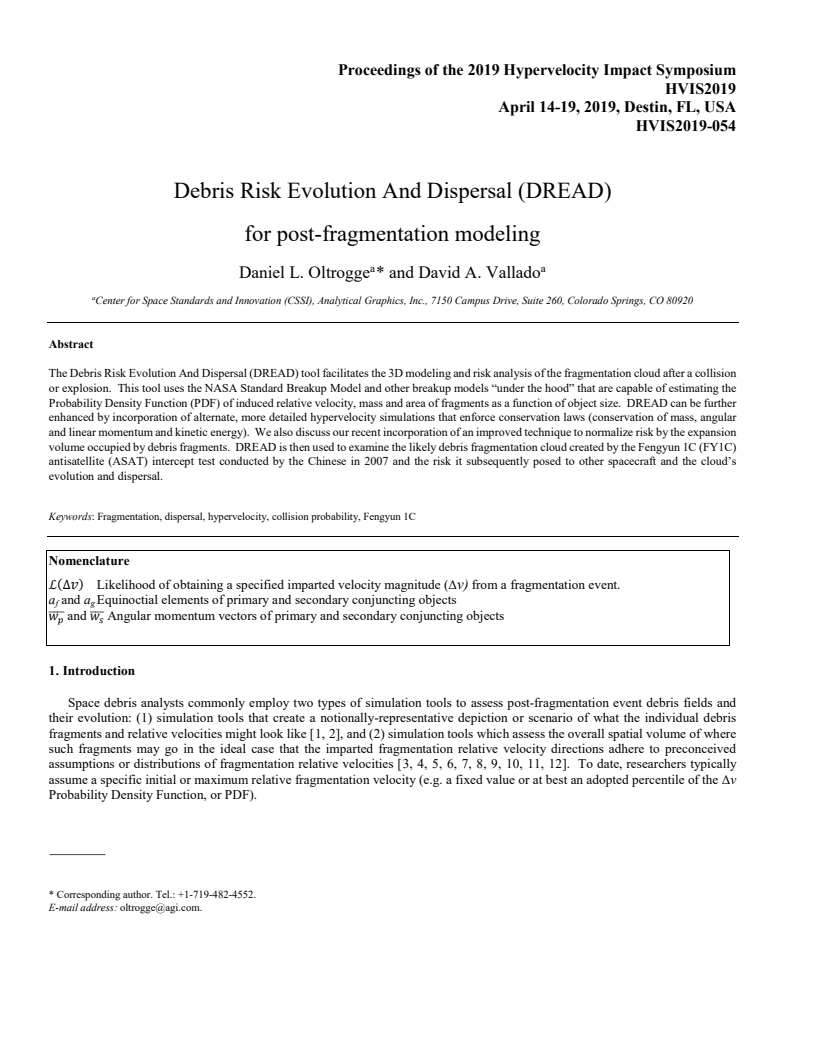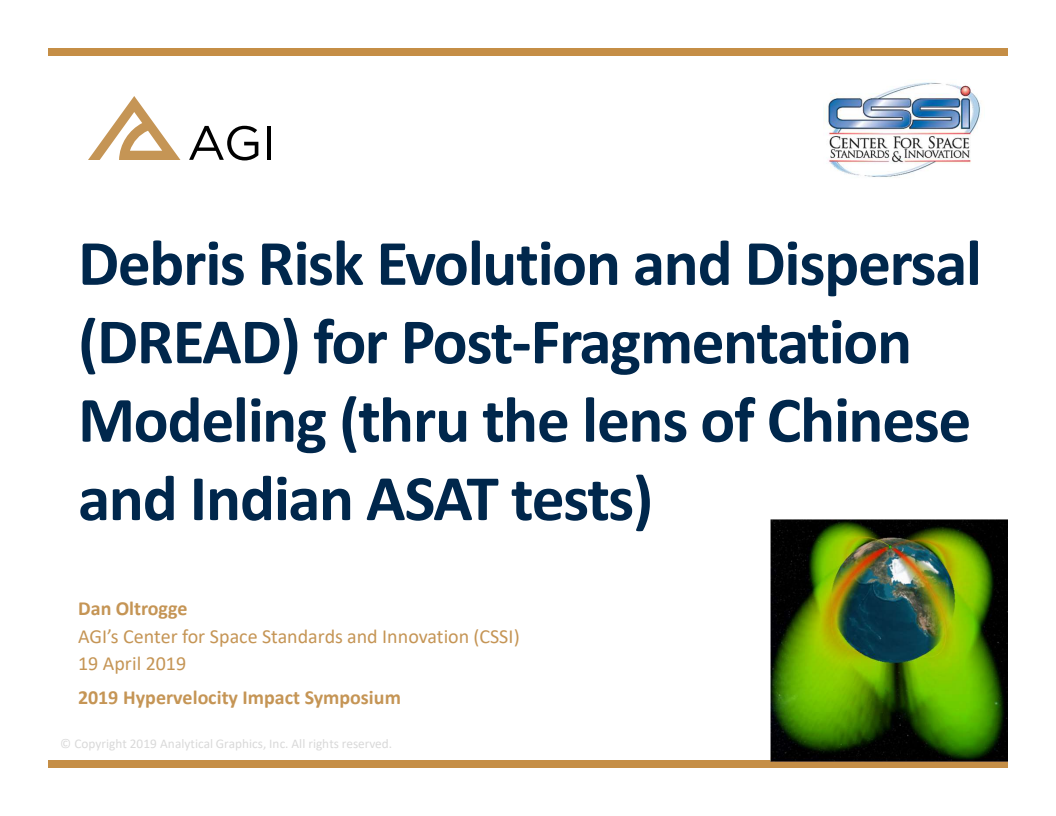Debris Risk Evolution And Dispersal (DREAD) for post-fragmentation modeling


Id: 280
Type: Peer-reviewed article
Published: 04/17/2019
Event: Hypervelocity Impact Symposium 2019
Authors:
Click an author to filter the list of related assets below.Abstract:
The Debris Risk Evolution And Dispersal (DREAD) tool facilitates the 3D modeling and risk analysis of the fragmentation cloud after a collision or explosion. This tool uses the NASA Standard Breakup Model and other breakup models “under the hood” that are capable of estimating the Probability Density Function (PDF) of induced relative velocity, mass and area of fragments as a function of object size. DREAD can be further enhanced by incorporation of alternate, more detailed hypervelocity simulations that enforce conservation laws (conservation of mass, angular and linear momentum and kinetic energy). We also discuss our recent incorporation of an improved technique to normalize risk by the expansion volume occupied by debris fragments. DREAD is then used to examine the likely debris fragmentation cloud created by the Fengyun 1C (FY1C) antisatellite (ASAT) intercept test conducted by the Chinese in 2007 and the risk it subsequently posed to other spacecraft and the cloud’s evolution and dispersal.
Keywords:
Click a keyword to filter the list of related assets below.Citation:
Oltrogge, D.L. and Vallado, D.A., “Debris Risk Evolution And Dispersal (DREAD) for Post-fragmentation Modeling,” 2019 Hypervelocity Impact Symposium, Destin, FL, USA, 14-19 April 2019, accessible at https://comspoc.com/Resources/Content/Private/C-20220424T142719/Paper/FINAL_9thaosfst_OltroggeDan_Vallado_David_v20.pdf.
Papers with related authors:

Using Spacebook and Cesium to Promote and Enhance Flight Safety
Read More
Actionability and Persistence Of Conjunction Data
Read More
Actionability and Persistence of Conjunction Data
Read More
Practical issues with using a full gravity field
Read More
Deep operator and SSA collaboration for space sustainability
Read More
Synthetic Covariance Production Using a New Digital Approach
Read More
Actionability and Persistence of Conjunction Data
Read More
DEEP OPERATOR AND SSA COLLABORATION FOR SPACE SUSTAINABILITY
Read More

Russian ASAT Debris Cloud Evolution and Risk
Read More
Results of comprehensive STCM data fusion experiment
Read More
Fragmentation event debris field evolution using 3d volumetric risk assessment
Read More
Application of New Debris Risk Evolution And Dissipation (DREAD) Tool to Characterize Post-Fragmentation Risk
Read More






LEO satellite behavior during the May 2024 Gannon geomagnetic storm
Read More
Contrasting the Inflection Points and Efforts in Space Traffic Coordination and Management
Read More
Addressing the debilitating effects of maneuvers on SSA accuracy and timeliness
Read More






Sequential Processing of ILRS Observations – Experiences over the last 5 years
Read More


Orbital Strategies to Mitigate the Solar Exclusion Effect on Space-Based Observation of the Geosynchronous Belt
Read More
New Consolidated Files for Earth Orientation Parameters and Space Weather Data
Read More
Updated Analytical Partials for Covariance Transformations and Optimization
Read More
Sequential Orbit Determination Using Satellite Laser Ranging
Read More
Improved SSA through orbit determination of Two Line Element Sets
Read More


Evaluating Gooding Angles-only Orbit Determination of Space Based Space Surveillance Measurements
Read More
ORBIT DETERMINATION ISSUES AND RESULTS TO INCORPORATE OPTICAL MEASUREMENTS IN CONJUNCTION OPERATIONS
Read More


Papers with related keywords:

Spacebook.com and Synthetic Covariances
Read More
Probability of Collision: Valuation, variability, visualization, and validity
Read More
Application of New Debris Risk Evolution And Dissipation (DREAD) Tool to Characterize Post-Fragmentation Risk
Read More
Probability of Collision: Valuation, Variability, Visualization, and Validity
Read MoreVideos with related keywords:
COMSPOC simulation of Chinese ASAT engagement of Fengyun spacecraft, including discrete fragment breakup and post-fragmentation debris cloud evolution.
Watch VideoDebris spread resulting from a hypothetical GEO collision.
Watch VideoHypersonic transport screening in an LCOLA tool
Watch VideoCOMSPOC simulation of Mission Shakti ASAT engagement, discrete fragment breakup, and post-fragmentation debris cloud evolution.
Watch Video